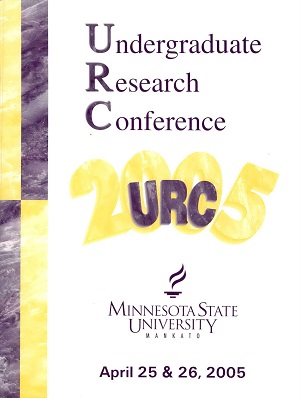Ferric Oxidation of Xylenol Orange as a Colorimetric Assay for Lipoxygenase Isoenzymes from Glycine Max
Location
CSU 253
Start Date
26-4-2005 10:00 AM
End Date
26-4-2005 12:00 PM
Student's Major
Biological Sciences
Student's College
Science, Engineering and Technology
Mentor's Name
James E. Rife
Mentor's Department
Chemistry and Geology
Mentor's College
Science, Engineering and Technology
Description
The focus of this study was to adapt the FOX method of Waslidge and Hayes (Anal. Biochem. 231, pp. 354-358, 1995) for assaying platelet lipoxygenase to make an assay for lipoxygenase isoenzymes from soybean (Glycine max.) The lipoxygenase enzyme is responsible for the formation of conjugated hydroperoxides from polyunsaturated fatty acids and molecular oxygen. Soybeans have multiple isoenzymes that catalyze this reaction. Three isoenzymes have been found in the seed while at least five different isoenzymes have been found in the vegetative tissue. Typical assays for lipoxygenase activity during enzyme purification have relied on monitoring the absorbance of the conjugated hydroperoxide at 230 nm. Such as assays have proven to be very time consuming. The FOX method allowed for batch assaying of multiple samples for lipoxygenase activity. The FOX method, or ferric oxidation of xylenol orange, took advantage of the fact that under low pH conditions, the hydroperoxides formed by the enzyme oxidize Fe2+ to Fe3+. The resulting ferric ions then oxidized xylenol orange to form a stable blue product that had an absorbance at 589 nm. The Waslidge and Hayes method was modified and optimized to assay soybean lipoxygenase isoenzymes using a spectrophotometer. This modified assay will expedite future enzyme isolation and purification studies.
Ferric Oxidation of Xylenol Orange as a Colorimetric Assay for Lipoxygenase Isoenzymes from Glycine Max
CSU 253
The focus of this study was to adapt the FOX method of Waslidge and Hayes (Anal. Biochem. 231, pp. 354-358, 1995) for assaying platelet lipoxygenase to make an assay for lipoxygenase isoenzymes from soybean (Glycine max.) The lipoxygenase enzyme is responsible for the formation of conjugated hydroperoxides from polyunsaturated fatty acids and molecular oxygen. Soybeans have multiple isoenzymes that catalyze this reaction. Three isoenzymes have been found in the seed while at least five different isoenzymes have been found in the vegetative tissue. Typical assays for lipoxygenase activity during enzyme purification have relied on monitoring the absorbance of the conjugated hydroperoxide at 230 nm. Such as assays have proven to be very time consuming. The FOX method allowed for batch assaying of multiple samples for lipoxygenase activity. The FOX method, or ferric oxidation of xylenol orange, took advantage of the fact that under low pH conditions, the hydroperoxides formed by the enzyme oxidize Fe2+ to Fe3+. The resulting ferric ions then oxidized xylenol orange to form a stable blue product that had an absorbance at 589 nm. The Waslidge and Hayes method was modified and optimized to assay soybean lipoxygenase isoenzymes using a spectrophotometer. This modified assay will expedite future enzyme isolation and purification studies.




